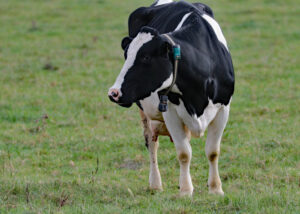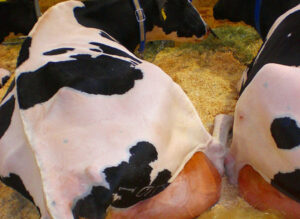Nuria García-Fernández
Digital dermatitis (DD) is a polybacterial disease that affects the skin on the heels of cattle. Round lesions occur along the coronary band of the claws, above the interdigital space next to the heel bulbs. It was first described in Italy in 1974 by Cheli and Morterallo, and it has become a growing problem worldwide for the dairy industry.
The bacteria most often associated with DD are spirochetes of the genus Treponema. Digital dermatitis is commonly treated with a topical application of tetracycline (paste or powdered form) directly to the lesion. Therefore, the risk of violative antibiotic levels in milk following topical application of tetracycline is high. The maximum residue limit for tetracycline in dairy milk is 100 ng/mL in the European Union and Canada, whereas in the United States the tolerance is 300 ng/mL. The Food Animal Residue Avoidance Databank recommends a 24-hours milk withdrawal interval for topical use of tetracycline in the United States.
A recent study published in Journal of Dairy Science determined the milk concentrations and withdrawal period of tetracycline following topical application at different doses. The researchers Cramer at al. (2019) selected 50 cows with active DD lesions on 2 feet from two Minnesotans farms, and applied one of the following five topical treatments on each affected foot:
- Paste: 6 mL of a water-propylene glycol blend (1:3) mixed with 2 or 5 g of tetracycline hydrochloride. The treatments were applied directly to the lesion using a paintbrush.
- Power: 2, 5, or 25 g of tetracycline as powder wrapped loosely under a bandage, which was removed after 48 hours.
Following treatment, milk samples were collected at 0, 8, 24, 32, 48, 56,72, 96, 120, 144, and 168 hours postdosing, and tested to determine concentration of tetracycline residues by using liquid chromatography coupled with MS/MS. Overall, the authors reported when using a high dose of tetracycline (25 g/foot or 50 g/cow), it is likely that tetracycline residue in milk would be below 100 ng/mL (maximum limit in the European Union and Canada) and 300 ng/mL (maximum limit in the USA) with a minimum withdrawal interval of 70 and 34 h post-treatment, respectively.
At lower dose levels (2-5 g/foot); however, the authors indicated the risk for antibiotic residues in milk was not dose-dependent. For example, compared with the 25 g power tetracycline group, the 2 g dosing group had higher than expected concentrations of tetracycline in milk (120–140 ng/mL) and a shorter estimated withdrawal period.
In conclusion, it is recommended to reduce the risk of violative antibiotic residues in milk from cows treated topically by applying a low dose of tetracycline. Moreover, it is very important testing of milk from every treated cow with a commercial antibiotic screening test for tetracycline that can be performed at the farm.
Reference
G. Cramer, L. Solano, and R. Johnson. 2019. Evaluation of tetracycline in milk following extra-label administration of topical tetracycline for digital dermatitis in dairy cattle. J. Dairy Sci. 102:883–895.











